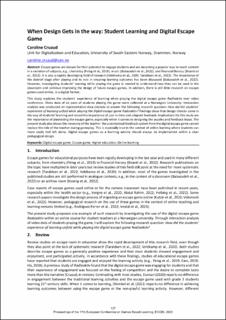| dc.description.abstract | Escape games are known for their potential to engage students and are becoming a popular way to teach content in a variation of subjects, e.g., chemistry (Peleg et al., 2019), music (Babazadeh et al., 2022), and financial literacy (Bisanti et al., 2022). It is also a rapidly developing field of research (Veldkamp et al., 2020, Taraldsen et al., 2022). The importance of the debrief stage after playing and its role in ensuring learning outcomes has been discussed (Babazadeh et al., 2022). However, investigating students’ learning while playing the game is needed to understand how they can be used in the classroom and continue improving the design of future escape games. In addition, there is still little research on escape games used online, in a digital format.
This study explores the students’ experience of learning when playing the digital escape game Radioaktiv over video conference. Video data of six pairs of students playing the game were collected at a Norwegian University. Interaction analysis was conducted on representative data extracts to answer the following research question: How did the students’ experience of learning unfold while playing the digital escape game Radioaktiv? Findings show that design choices came in the way of students’ learning and reveal the importance of just-in-time and adapted feedback. Implications for this study are the importance of playtesting the escape game, especially when it comes to designing the puzzles and feedback loops. The present study also shows the necessity of the teacher: the automatised feedback system from the digital escape game cannot replace the role of the teacher during gameplay. This is especially true in the context of online learning where students can more easily feel left alone. Digital escape games as a learning activity should always be implemented within a clear pedagogical design. | en_US |
